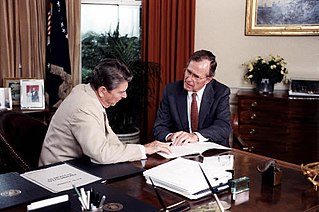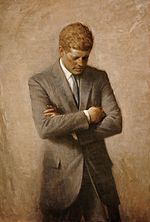
The president of the United States (POTUS) is the head of state and head of government of the United States of America. The president directs the executive branch of the federal government and is the commander-in-chief of the United States Armed Forces.

The Cabinet of the United States is a body consisting of the vice president of the United States and the heads of the executive branch's departments in the federal government of the United States. It is the principal official advisory body to the president of the United States. The president chairs the meetings but is not formally a member of the Cabinet. The heads of departments, appointed by the president and confirmed by the Senate, are members of the Cabinet, and acting department heads also participate in Cabinet meetings whether or not they have been officially nominated for Senate confirmation. The president may designate heads of other agencies and non-Senate-confirmed members of the Executive Office of the President as members of the Cabinet.

The Executive Office of the President (EOP) comprises the offices and agencies that support the work of the president at the center of the executive branch of the United States federal government. The EOP consists of several offices and agencies, such as the White House Office, the National Security Council, and the Office of Management and Budget.

The federal government of the United States is the national government of the United States, a federal republic in North America, composed of 50 states, a city within a federal district, five major self-governing territories and several island possessions. The federal government is composed of three distinct branches: legislative, executive, and judicial, whose powers are vested by the U.S. Constitution in the Congress, the president and the federal courts, respectively. The powers and duties of these branches are further defined by acts of Congress, including the creation of executive departments and courts inferior to the Supreme Court.

The War Powers Resolution is a federal law intended to check the U.S. president's power to commit the United States to an armed conflict without the consent of the U.S. Congress. The resolution was adopted in the form of a United States congressional joint resolution. It provides that the president can send the U.S. Armed Forces into action abroad only by declaration of war by Congress, "statutory authorization", or in case of "a national emergency created by attack upon the United States, its territories or possessions, or its armed forces".

In the United States, an executive order is a directive by the president of the United States that manages operations of the federal government. The legal or constitutional basis for executive orders has multiple sources. Article Two of the United States Constitution gives presidents broad executive and enforcement authority to use their discretion to determine how to enforce the law or to otherwise manage the resources and staff of the executive branch. The ability to make such orders is also based on expressed or implied Acts of Congress that delegate to the president some degree of discretionary power.
Imperial Presidency is a term applied to the modern presidency of the United States. It became popular in the 1960s and served as the title of a 1973 book by historian Arthur M. Schlesinger, Jr., who wrote The Imperial Presidency to address two concerns: that the presidency was uncontrollable and that it had exceeded its constitutional limits. According to Professor of political science Thomas E. Cronin, author of The State of the Presidency, the Imperial Presidency is a term used to define a danger to the American constitutional system by allowing the Presidency to create and abuse presidential prerogative during national emergencies. Its prerogative was based on: (1) presidential war powers vaguely defined in the constitution, and (2) secrecy - a system used that shielded the Presidency from the usual checks and balances afforded by the legislative and judicial branches.
The United States federal executive departments are the principal units of the executive branch of the federal government of the United States. They are analogous to ministries common in parliamentary or semi-presidential systems but they are led by a head of government who is also the head of state. The executive departments are the administrative arms of the president of the United States. There are currently 15 executive departments.
The doctrine of nondelegation is the theory that one branch of government must not authorize another entity to exercise the power or function which it is constitutionally authorized to exercise itself. It is explicit or implicit in all written constitutions that impose a strict structural separation of powers. It is usually applied in questions of constitutionally improper delegations of powers of any of the three branches of government to either of the other, to the administrative state, or to private entities. Although it is usually constitutional for executive officials to delegate executive powers to executive branch subordinates, there can also be improper delegations of powers within an executive branch.

Separation of powers is a political doctrine originating in the writings of Charles de Secondat, Baron de Montesquieu in The Spirit of the Laws, in which he argued for a constitutional government with three separate branches, each of which would have defined abilities to check the powers of the others. This philosophy heavily influenced the writing of the United States Constitution, according to which the Legislative, Executive, and Judicial branches of the United States government are kept distinct in order to prevent abuse of power. This United States form of separation of powers is associated with a system of checks and balances.
Immigration and Naturalization Service v. Chadha, 462 U.S. 919 (1983), was a United States Supreme Court case ruling in 1983 that the one-house legislative veto violated the constitutional separation of powers.
The legislative veto was a feature of dozens of statutes enacted by the United States federal government between approximately 1930 and 1980, until held unconstitutional by the U.S. Supreme Court in 1983. It is a provision whereby Congress passes a statute granting authority to the President and reserving for itself the ability to override, through simple majority vote, individual actions taken by the President pursuant to that authority.
The powers of the president of the United States include those explicitly granted by Article II of the United States Constitution as well as those granted by Acts of Congress, implied powers, and also a great deal of soft power that is attached to the presidency.
The unitary executive theory is a theory of United States constitutional law which holds that the President of the United States possesses the power to control the entire federal executive branch. The doctrine is rooted in Article Two of the United States Constitution, which vests "the executive power" of the United States in the President. Although that general principle is widely accepted, there is disagreement about the strength and scope of the doctrine. It can be said that some favor a "strongly unitary" executive, while others favor a "weakly unitary" executive. The former group argue, for example, that Congress's power to interfere with intra-executive decision-making is limited, and that the President can control policy-making by all executive agencies within the limits set for those agencies by Congress. Still others agree that the Constitution requires a unitary executive, but believe this to be harmful, and propose its abolition by constitutional amendment.
Congressional oversight is oversight by the United States Congress over the Executive Branch, including the numerous U.S. federal agencies. Congressional oversight includes the review, monitoring, and supervision of federal agencies, programs, activities, and policy implementation. Congress exercises this power largely through its congressional committee system. Oversight also occurs in a wide variety of congressional activities and contexts. These include authorization, appropriations, investigative, and legislative hearings by standing committees; which is specialized investigations by select committees; and reviews and studies by congressional support agencies and staff.

A signing statement is a written pronouncement issued by the President of the United States upon the signing of a bill into law. They are usually printed along with the bill in United States Code Congressional and Administrative News (USCCAN). The statements begin with wording such as "This bill, which I have signed today" and continue with a brief description of the bill and often several paragraphs of political commentary.

The National Emergencies Act (NEA) is a United States federal law passed to end all previous national emergencies and to formalize the emergency powers of the President.

The Reorganization Act of 1939, Pub.L. 76–19, 53 Stat. 561, enacted April 3, 1939, codified at 31 U.S.C. § 701, is an American Act of Congress which gave the President of the United States the authority to hire additional confidential staff and reorganize the executive branch for two years subject to legislative veto. It was the first major, planned reorganization of the executive branch of the government of the United States since 1787. The Act led to Reorganization Plan No. 1, which created the Executive Office of the President.
The U.S. Congress in relation to the president and Supreme Court has the role of chief legislative body of the United States. However, the Founding Fathers of the United States built a system in which three powerful branches of the government, using a series of checks and balances, could limit each other's power. As a result, it helps to understand how the United States Congress interacts with the presidency as well as the Supreme Court to understand how it operates as a group.
A presidential directive, or executive action, is a written or oral instruction or declaration issued by the president of the United States, which may draw upon the powers vested in the president by the U.S. Constitution, statutory law, or, in certain cases, congressional and judicial acquiescence. Such directives, which have been issued since the earliest days of the federal government, have become known by various names, and some have prescribed forms and purposes. Presidential directives remain in effect until they are revoked, which the president is free to do. The classification of presidential directives is not easily done, as the distinction between the types can be quite arbitrary, arising from convenience and bureaucratic evolution, and none are defined in the Constitution. Furthermore, the different types may overlap. As one legal scholar put it: "it is a bit misleading to overclassify presidential directives as comprising separate and distinct 'types' just because they have different headings at the top of the first page." In terms of legal applicability, what matters is the substance of the directive, not the form, unless a certain kind of directive is specifically required by relevant statute.


















